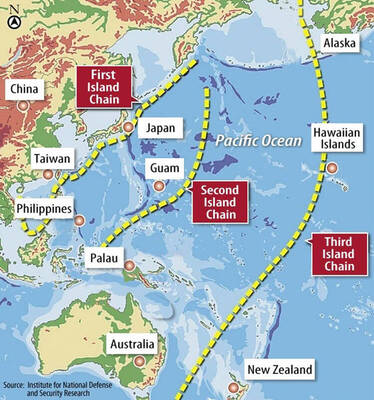National Sun Yat-sen University professor Chen Yang-yi’s (陳陽益) dream of using the Kuroshio Current to generate electricity has been proved viable after seven years of testing, and Chen hopes that by 2020 the project would be able to produce 1 gigawatt (GW) of electricity per day.
Chen’s research team said that it reported the results to Premier Lin Chuan (林全) on Saturday.
According to Chen, the Kuroshio Power Plant Development Project late last month successfully deployed a floating platform anchored to a sunken ship, the first such platform in Taiwan and the first system to test the viability of power generation by ocean currents.
The project was the first to turn on low-speed generators submerged in water currents flowing at 0.45m per second, Chen said, adding that the generators were kept running for 60 hours.
The team first used tugboats off Pingtung County’s Siaoliouciou Island (小琉球) last year to tow their third generator through ocean currents at a speed of 1.43m per second, Chen said, adding that average power generation was 32.57 kilowatts (kW).
That was the first time a research team towed a generator to simulate ocean current speeds and generated power, Chen said.
On July 23, the team deployed a multipurpose platform 25km southeast of Oluanpi (鵝鑾鼻), which it anchored to a foundation 900m deep converted from an abandoned ship, Chen said.
From July 25 to July 29, the team ran consecutive tests as the Kuroshio Current flowed past the platform at a depth of 30m, with currents traveling at 1.27m per second, generating an average of 26.31kW, he said.
“It was a successful trial,” Chen said.
The team plans to move to Jioupeng Bay (九鵬灣) in Pingtung next year for a trial run, which it hopes will generate 2 megawatts for commercial operations, Chen said
If the test results are positive, the system could become a replacement for the Ma-anshan Nuclear Power Plant, as it is projected to be able to generate 1GW by 2020, which would move the nation one step closer to the government’s goal of a “nuclear-power-free homeland.”
While many nations have been attempting to use sea currents to generate power, most are still at the design stage and none have had a successful trial, he said.
According to Chen, Japan last year demonstrated a sea current generation system, but said that it would not conduct live trials until 2020, meaning that Taiwan’s research has surpassed that of other nations.
Chen, who served as president of the university’s College of Marine Science, launched the Kuroshio Current power generation research project in 2009 in collaboration with research teams from the National Applied Research Laboratories and National Cheng Kung University’s Tainan Hydraulics Laboratory.
The team also collaborates with Wanchi Steel Industrial Co (萬機鋼鐵) on technological matters.

The US government has signed defense cooperation agreements with Japan and the Philippines to boost the deterrence capabilities of countries in the first island chain, a report by the National Security Bureau (NSB) showed. The main countries on the first island chain include the two nations and Taiwan. The bureau is to present the report at a meeting of the legislature’s Foreign Affairs and National Defense Committee tomorrow. The US military has deployed Typhon missile systems to Japan’s Yamaguchi Prefecture and Zambales province in the Philippines during their joint military exercises. It has also installed NMESIS anti-ship systems in Japan’s Okinawa

‘WIN-WIN’: The Philippines, and central and eastern European countries are important potential drone cooperation partners, Minister of Foreign Affairs Lin Chia-lung said Minister of Foreign Affairs Lin Chia-lung (林佳龍) in an interview published yesterday confirmed that there are joint ventures between Taiwan and Poland in the drone industry. Lin made the remark in an exclusive interview with the Chinese-language Liberty Times (the Taipei Times’ sister paper). The government-backed Taiwan Excellence Drone International Business Opportunities Alliance and the Polish Chamber of Unmanned Systems on Wednesday last week signed a memorandum of understanding in Poland to develop a “non-China” supply chain for drones and work together on key technologies. Asked if Taiwan prioritized Poland among central and eastern European countries in drone collaboration, Lin

The Chien Feng IV (勁蜂, Mighty Hornet) loitering munition is on track to enter flight tests next month in connection with potential adoption by Taiwanese and US armed forces, a government source said yesterday. The kamikaze drone, which boasts a range of 1,000km, debuted at the Taipei Aerospace and Defense Technology Exhibition in September, the official said on condition of anonymity. The Chungshan Institute of Science and Technology and US-based Kratos Defense jointly developed the platform by leveraging the engine and airframe of the latter’s MQM-178 Firejet target drone, they said. The uncrewed aerial vehicle is designed to utilize an artificial intelligence computer

Renewed border fighting between Thailand and Cambodia showed no signs of abating yesterday, leaving hundreds of thousands of displaced people in both countries living in strained conditions as more flooded into temporary shelters. Reporters on the Thai side of the border heard sounds of outgoing, indirect fire yesterday. About 400,000 people have been evacuated from affected areas in Thailand and about 700 schools closed while fighting was ongoing in four border provinces, said Thai Rear Admiral Surasant Kongsiri, a spokesman for the military. Cambodia evacuated more than 127,000 villagers and closed hundreds of schools, the Thai Ministry of Defense said. Thailand’s military announced that